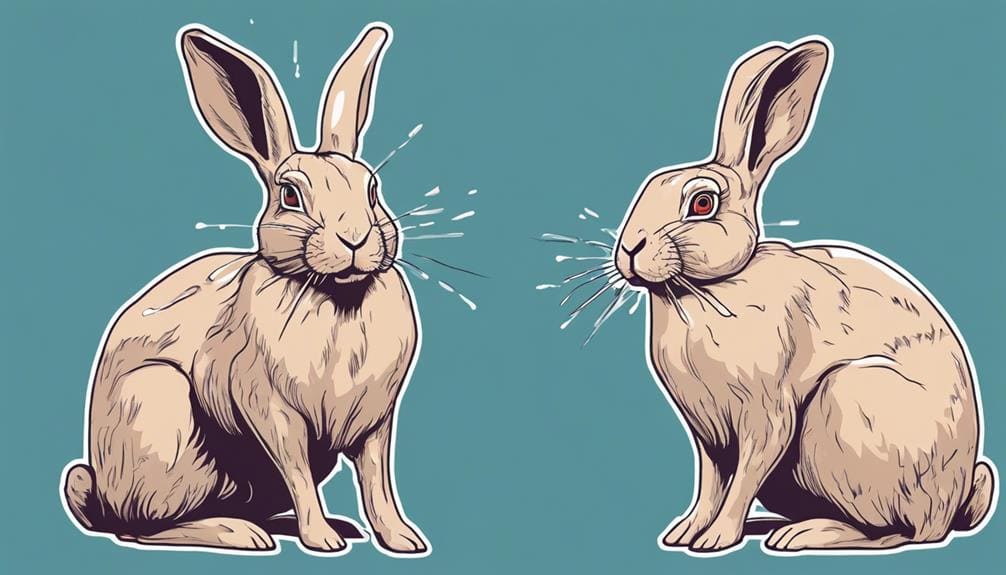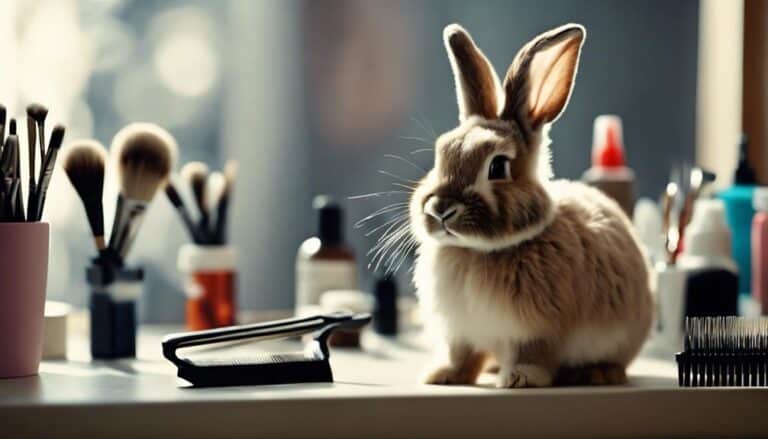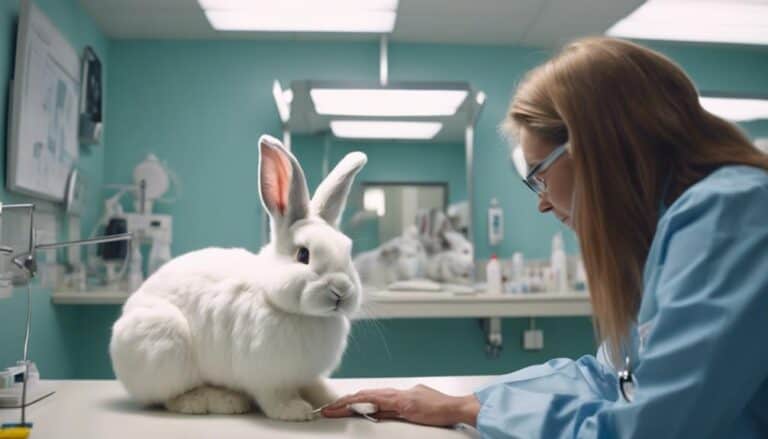Have you ever noticed your rabbit showing signs of respiratory distress? While rabbits are generally hardy pets, they are susceptible to various respiratory problems that can impact their health and well-being.
From pasteurellosis to snuffles and viral diseases like VHD, understanding these common respiratory issues is essential for providing timely care and ensuring your furry companion's longevity.
Let's explore the different respiratory problems that can affect rabbits and how to best manage them to keep your pet healthy and happy.
Contents
- 1 Key Takeaways
- 2 Pasteurellosis in Rabbits
- 3 Myxomatosis and Rabbits
- 4 Viral Haemorrhagic Disease (VHD) in Rabbits
- 5 Snuffles and Respiratory Infections
- 6 Bordatella and Its Impact
- 7 Rabbit Syphilis and Respiratory Health
- 8 Do Regular Check-Ups Help Prevent Common Respiratory Problems in Rabbits?
- 9 Frequently Asked Questions
- 10 Conclusion
Key Takeaways
- Snuffles and pneumonia are common respiratory problems in rabbits, often caused by infections.
- Upper respiratory tract infections can lead to nasal discharge in rabbits.
- Allergic respiratory disease in rabbits can be triggered by environmental factors.
- Dental issues like tooth root abscesses can result in respiratory problems for rabbits.
Pasteurellosis in Rabbits

If your rabbit is showing signs of rhinitis, sinusitis, or otitis, it may be suffering from Pasteurellosis, the primary respiratory disease in domestic rabbits caused by Pasteurella multocida. Pasteurellosis is a serious respiratory infection that commonly affects infected rabbits. This gram-negative coccobacillus can lead to a range of clinical manifestations, including nasal discharge, sneezing, head tilt, and in severe cases, abscesses in various organs.
Transmission of Pasteurella typically occurs through aerosols, direct contact with infected animals, or contaminated objects. It's essential to isolate infected rabbits to prevent the spread of the disease to other members of the colony.
Prompt treatment is essential when dealing with Pasteurellosis. Effective antimicrobials that target Pasteurella multocida are usually prescribed by veterinarians to combat the infection. Additionally, maintaining good hygiene practices and providing a stress-free environment can help reduce the risk of Pasteurella infections in rabbits. Regular veterinary check-ups are also recommended to monitor and manage respiratory health in rabbits.
Myxomatosis and Rabbits
Myxomatosis is a serious viral disease that affects rabbits, causing swelling in various parts of their bodies, such as the head, eyelids, and genitals.
To safeguard your rabbits, make sure they're vaccinated against myxomatosis starting at 6 weeks of age, as the disease is transmitted by fleas and mosquitoes.
Understanding the symptoms and taking preventive measures can help protect your rabbits from this deadly infection.
Myxomatosis Overview
With a high mortality rate, Myxomatosis is an aggressive viral disease in rabbits that manifests through swelling of the head, eyelids, and genitals in infected rabbits.
Here is some important information about Myxomatosis:
- Myxomatosis is transmitted through rabbit fleas and mosquitoes, leading to rapid spread among rabbit populations.
- The vaccination against Myxomatosis is available for rabbits as early as 6 weeks of age, offering protection against this deadly disease.
- Infected rabbits typically show symptoms within 7-14 days after exposure to the virus, with a rapid progression of the disease.
- It's essential to be proactive in protecting your rabbits from Myxomatosis through vaccination and preventative measures to safeguard their well-being.
Prevention Measures
To protect your rabbits from Myxomatosis, ensuring timely vaccination and creating a stress-free living environment are important preventive measures. Myxomatosis is a viral respiratory disease in rabbits transmitted by fleas and mosquitoes, with a high mortality rate and rapid onset.
Vaccination against Myxomatosis is available for rabbits as young as 6 weeks old. This vaccine is vital in preventing infections in rabbits and can greatly reduce the risk of contracting the disease. Additionally, maintaining a stress-free environment for your rabbits is essential for their overall health and well-being.
Regular veterinary check-ups can also help in early detection of any potential respiratory issues, ensuring prompt treatment and management. By prioritizing vaccination and a stress-free environment, you can safeguard your rabbits against this severe respiratory disease.
Viral Haemorrhagic Disease (VHD) in Rabbits

Viral Haemorrhagic Disease (VHD) in rabbits poses a significant threat due to its high mortality rate and rapid spread among rabbit populations. Here are some key facts about VHD:
- High Mortality Rate: VHD has a mortality rate ranging from 30% to 90% in affected colonies, making it a deadly disease for rabbits.
- Contagious Nature: This disease is highly contagious among rabbits and can lead to rapid death, necessitating quick intervention to prevent further spread.
- Symptoms of VHD: Infected rabbits may exhibit symptoms such as difficulty breathing and bloody froth discharge, indicating severe respiratory distress.
- Vaccination: To protect rabbits from VHD, vaccination is recommended starting from 12 weeks of age. Vaccination plays an important role in preventing the spread of this lethal viral infection.
Understanding these facts about VHD is important for rabbit owners and caretakers to safeguard their furry companions from this dangerous disease. Regular vaccinations and prompt identification of symptoms can help in controlling the impact of VHD on rabbit populations.
Snuffles and Respiratory Infections
If your rabbit starts showing signs like weepy eyes, nose discharge, sneezing, fast breathing, or lethargy, they might've snuffles, a common respiratory infection.
Snuffles in rabbits are often caused by bacteria like Pasteurella and Bordetella.
Understanding the causes, symptoms, and available treatment options is essential for managing respiratory infections in your furry friend.
Causes of Snuffles
Snuffles in rabbits commonly arises due to bacterial infections, particularly from culprits like Pasteurella and Bordetella. The bacteria can lead to symptoms like nasal discharge, sneezing, wheezing, and respiratory distress in affected rabbits. It's essential to note that snuffles can be highly contagious among rabbits through respiratory contact and body secretions. If left untreated, snuffles can progress to chronic sinusitis and pneumonia, leading to severe complications. Treatment typically involves antibiotics and probiotics to combat the bacterial infections effectively.
- Bacterial Infections: Pasteurella multocida and Bordetella bronchiseptica are common culprits.
- Symptoms: Include nasal discharge, sneezing, wheezing, and respiratory distress.
- Contagious Nature: Spread through respiratory contact and body secretions.
- Complications: Untreated snuffles can lead to chronic sinusitis and pneumonia.
Symptoms to Watch
Watch for common symptoms like weepy eyes, nasal discharge, sneezing, and fast breathing in rabbits to identify potential respiratory problems early on. Rabbits with respiratory infections may also show signs of low energy, wheezing, weight loss, and a reduced appetite.
Keep an eye out for stained fur around the eyes and nose from excessive cleaning and be alert to sudden death as rabbits are skilled at hiding their symptoms. Respiratory infections, if untreated, can be fatal in rabbits.
It's important to monitor closely for these symptoms due to rabbits' susceptibility to serious respiratory diseases like pasteurellosis and bordetella infections. Early detection and intervention play an important role in the successful treatment of nasal discharge, weepy eyes, and respiratory infections in rabbits.
Treatment Options Available
When addressing respiratory infections like snuffles in rabbits, the treatment options available typically involve intensive care with oxygen, anti-inflammatories, and antibiotics to effectively manage breathing issues.
Here are some key points to bear in mind:
- Hospitalization: Rabbits with severe respiratory infections may require hospitalization for close monitoring and specialized care.
- Antibiotics: Administering antibiotics is essential to combat the bacterial infection causing respiratory issues in rabbits.
- Supportive Treatments: Providing supportive care such as fluid drips can help stabilize the rabbit's breathing.
- Home Care: Following the veterinarian's prescribed antibiotics and medications at home is vital for the rabbit's recovery from a respiratory infection.
Bordatella and Its Impact
What impact does Bordetella have on rabbits' upper airway health?
Bordetella is a bacterial agent that can cause upper respiratory issues in rabbits, commonly leading to a condition known as snuffles.
While some rabbits may carry Bordetella without displaying clinical symptoms, infection can manifest as snoring with less nasal discharge compared to Pasteurella infections.
Although Bordetella infections are generally less severe in rabbits when compared to Pasteurella, prompt treatment is essential. Effective management typically involves the use of antibiotics to address the bacterial infection.
Monitoring for symptoms such as snoring and changes in nasal discharge is critical for early detection and intervention.
Rabbit Syphilis and Respiratory Health

Discussing Rabbit Syphilis and its impact on respiratory health sheds light on a specific bacterial infection that can affect rabbits' overall well-being. When considering respiratory health in rabbits, being aware of Rabbit Syphilis is important due to its potential implications.
Here are some key points to remember about Rabbit Syphilis and its relationship to respiratory health:
- Rabbit Syphilis is caused by Treponema cuniculi and is primarily transmitted through sexual or body fluid contact.
- Symptoms of Rabbit Syphilis often manifest as lesions around the nose and genitalia in infected rabbits, impacting their respiratory system indirectly.
- Treatment for Rabbit Syphilis typically involves weekly penicillin injections administered by a veterinarian to combat the bacterial infection.
- Some veterinarians may hesitate to treat Rabbit Syphilis with penicillin due to potential contraindications or side effects, emphasizing the importance of seeking professional guidance when dealing with this condition.
Understanding how Rabbit Syphilis can influence respiratory health is essential for maintaining the well-being of rabbits and addressing any potential concerns promptly.
Do Regular Check-Ups Help Prevent Common Respiratory Problems in Rabbits?
Regular bunny health checkups are needed to prevent common respiratory problems in rabbits. Professional veterinary examinations can help detect any early signs of respiratory issues, such as sneezing or wheezing, and provide appropriate treatment before it becomes a serious problem. Keep your furry friend healthy with routine check-ups.
Frequently Asked Questions
What Is the Most Common Cause of Respiratory Disease in Rabbits?
Pasteurellosis, caused by Pasteurella multocida, is the primary respiratory disease in rabbits. Treat with antimicrobials. Preventive measures include good hygiene and reducing stress. Risk factors include overcrowding. Symptoms include rhinitis and sinusitis. Long term effects can lead to chronic respiratory issues.
What Can I Give My Rabbit for Respiratory Infection?
If your rabbit has a respiratory infection, consult a veterinarian for antibiotics. Consider nebulization therapy with prescribed medications. Assure hydration and offer fresh water. Herbal remedies and probiotics may aid recovery. Seek professional advice for home care.
What Does a Rabbit With a Respiratory Infection Sound Like?
When a rabbit has a respiratory infection, you may hear frequent sneezing, wheezing, or labored breathing. Watch for nasal discharge and noisy breathing. If your rabbit's breath sounds off, seek vet care. Preventive measures include clean living spaces and prompt treatment.
How Do I Know if My Rabbit Is Struggling to Breathe?
When your rabbit's breath feels heavy and anxious, notice how their chest rises and falls with a struggle. If you see this, rush to the vet for help. Keep their cage clean to prevent future issues.
Conclusion
To sum up, respiratory problems in rabbits, such as pasteurellosis, myxomatosis, VHD, snuffles, Bordetella, and syphilis, can pose serious health risks. By being proactive in monitoring and addressing any signs of respiratory distress, rabbit owners can guarantee the well-being of their furry companions.
Regular veterinary check-ups, proper hygiene practices, and prompt treatment can help prevent and manage these respiratory issues effectively. Stay vigilant, stay informed, and keep your rabbits healthy and happy.






